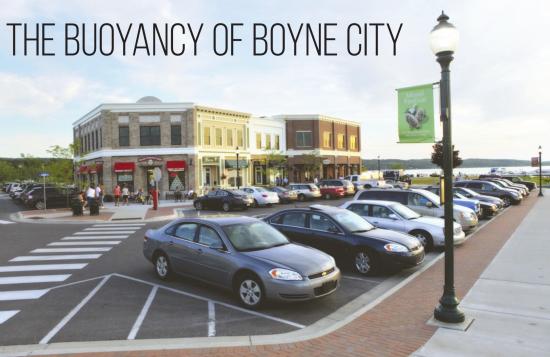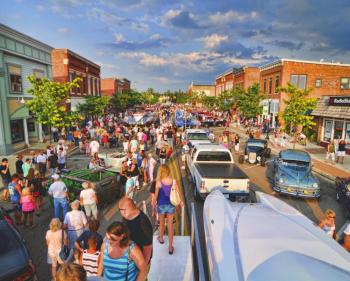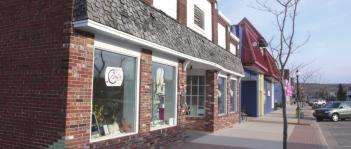The Buoyancy of Boyne City
April 22, 2016

For decades, the word Boyne was synonymous with resort — as in, Boyne Mountain Resort and Boyne Highlands Resort.
The four-season ski and golf properties were the primary economic driver of the region and the main reason tourists found themselves in the small enclave of Boyne City.
In the last 10 years, something has shifted in this community of just less than 4,000 residents. Visitors still flock to the resorts, but now they’re also likely to be strolling Boyne City’s downtown streets in the summer, taking in winter concerts at Freshwater Art Gallery, lining up for dinner outside Café Sante or checking out the renovations at the Dilworth Hotel and Glen Catt’s SoBo Development. Some of those visitors will even consider moving to the resort town; Boyne City is one of the few Michigan cities that grew in population in the last decade, outpacing even Traverse City.
So what’s the secret to Boyne City’s surprising renaissance? Community leaders highlight three key ingredients in the city’s recipe for success.
1 Boyne City Main StreetPerhaps no decision has been more critical to Boyne City’s growth than city officials and residents forming the volunteer-led Boyne City Main Street in 2003. The city became one of the first communities in the state accepted into Michigan’s Main Street Center program, which provides funding and technical support for economic development projects that emphasize historic preservation.
“One of the game changers for the city was taking the risk and applying to be a Main Street community,” said Boyne City Manager Michael Cain. “It really opened the doors and allowed us to try a lot of new things. It helped us acquire millions of dollars in grants…and opened our relationship with people at the state and national levels.”
In exchange for committing to a four-point economic strategy — which helps guide downtown design, business diversification, marketing and community collaboration — Main Street cities qualify for government funding on a variety of projects. In the last decade, Boyne City has invested more than $6 million in downtown infrastructure improvements in partnership with the state, including new sewer and water mains, sidewalk/curb/gutter upgrades, street reconstruction projects and utility improvements.
The program has also helped fuel the rehabilitation of storefronts in the city’s downtown district.
“We received grant money to do that…because [the program] stresses historic preservation,” said Boyne Area Chamber of Commerce Executive Director Jim Baumann. “It’s been very helpful in providing leadership and assistance to make the town better.”
Boyne City Main Street volunteers also created one of the city’s most popular events, Stroll the Streets. Every Friday from 6–9pm, June through Labor Day weekend, musicians, street performers, caricature artists, balloon twisters and other family-friendly entertainers flood downtown Boyne City. The event draws huge crowds to downtown, helping support retailers and restaurants and creating a positive buzz throughout the community. Baumann cites it as one of his favorite aspects of living in the city.
“It’s a big deal in Boyne City,” he said. “For at least 14 weeks, there are 6–8 bands on every street corner downtown on Friday. It’s all free [to the public], sponsored by business donations. It makes for a very fun atmosphere.”
2 Hometown Heroes
Another key factor in Boyne City’s success: a commitment from local residents to invest in their community.
Developer Glen Catt has had family connections to northern Michigan for several generations. His great-grandfather was part of the firm that constructed US-31, while his grandfather was the eponymous Glen behind supermarket chain Glen’s Markets. Looking to make his own mark on the region, Catt — who owns commercial real estate development firm Catt Development — bought property on Boyne City’s Water Street in 2008 with the goal of building a multi-million dollar mixed-use development.
“Of course, that fall the economy started collapsing,” Catt chuckled, recalling the unfortunate timing. “We looked at it as a family and thought, we can sell the property and take a loss, or we can wait it out — but you’ve got costs involved in waiting it out. So we looked at, well, how can we move forward?” Catt knew an anchor tenant was key for One Water Street to succeed. Thankfully, restaurant group Magnum Hospitality, which had already created one culinary destination in Boyne City with Red Mesa Grill, was willing to take another leap. In 2010, Magnum opened European bistro Café Sante on the property, creating a new draw downtown — and the immediate boost Catt needed to complete the development, which includes an on-site marina and tenants like Alpine Chocolate Haus, Kidd & Leavy Real Estate and My Community Dental Centers.
“That site was like a phoenix rising from the ashes,” said Cain. “We had this hole there downtown and were wondering what was going to happen with it, and then Glen came in. He was a godsend for our community: the right person at the right time.”
Catt’s next project also promises to be a boon for downtown Boyne City. The SoBo Development consists of two renovated historic properties at 202 and 210 South Lake Street that will house a highly anticipated second location for Traverse City’s 7 Monks Taproom — set to open in June — and a new branch of Northern Michigan Sports Medicine Center, opening in July. Only a few years ago, Catt had to seek out tenants to fill One Water Street, but today he’s already had nearly a dozen retail inquiries for the 2–3 remaining vacant spaces in SoBo.
Both Cain and Baumann credit Catt for starting a downtown development trend that has spurred others to invest, nearly eliminating vacancies in the downtown district. Other recent projects include the newly opened Boyne City Bakery on Lake Street, started by residents Rebecca Harris and Thomas Greetis who also hope to use the space as a commercial kitchen incubator for other entrepreneurs, and the renovation of the historic Dilworth Hotel on Water Street, built in 1912 and listed on the National Register of Historic Places.
Dilworth Hotel owner Bob Grove is shepherding that project as a “labor of love,” Cain says, in a manner similar to other residents who have stepped forward to make their mark in Boyne City. When complete, the Dilworth Hotel will operate as a three-story boutique hotel with an on-site restaurant and pub. The project was recently awarded a $1 million state grant for blight removal and job creation.
“[Grove] was someone who just got tired of seeing one of our downtown historic buildings deteriorating and wanted to do something about it,” Cain said.
3 Team BoyneThat “can-do” spirit of commitment and cooperation may be one of the most intangible — yet defining — aspects of Boyne City’s success. Each month, a network of community leaders and residents calling themselves Team Boyne meet to discuss opportunities and challenges facing Boyne City. Representatives from city government, the chamber, the school district, the library, the arts community and local businesses are all present; new or potential entrepreneurs are also invited to meet community leaders and share any questions or concerns they have.

“We roll out the welcome mat and ask if there’s anything we can do to help you succeed,” said Baumann. “We all work well together; we’re all going in the same direction.
There are no turf wars or big egos here. We’re all trying to make things happen and bring good development to town.”
City staff also hope to streamline government services and better assist community residents in a new $7 million municipal campus under construction on Lake Street by Veterans Park. The facility will consolidate city hall offices; the city’s police, fire and ambulance departments; the city museum and Michigan State University Extension offices into one complex. Residents approved a millage for the project last year.
There are still challenges ahead for Boyne City, officials say — as well as opportunities. As with many communities, Boyne City is struggling to meet demand for affordable and workforce housing, which has created difficulties in attracting enough employees to keep up with rapid development.
Community leaders want to do even more to transition the region from its seasonallybased roots into a year-round economy. In this regard, the renovation of the historic Boyne Theater is also high on the city’s to-do list.
Both residents and leaders express confidence that Boyne City’s unique spirit of collaboration and DIY pride is more than adequate to meet the challenges ahead.
Trending

The Valleys and Hills of Doon Brae
Whether you’re a single-digit handicap or a duffer who doesn’t know a mashie from a niblick, there’s a n... Read More >>
The Garden Theater’s Green Energy Roof
In 2018, Garden Theater owners Rick and Jennie Schmitt and Blake and Marci Brooks looked into installing solar panels on t... Read More >>
Earth Day Up North
Happy Earth Day! If you want to celebrate our favorite planet, here are a few activities happening around the North. On Ap... Read More >>


